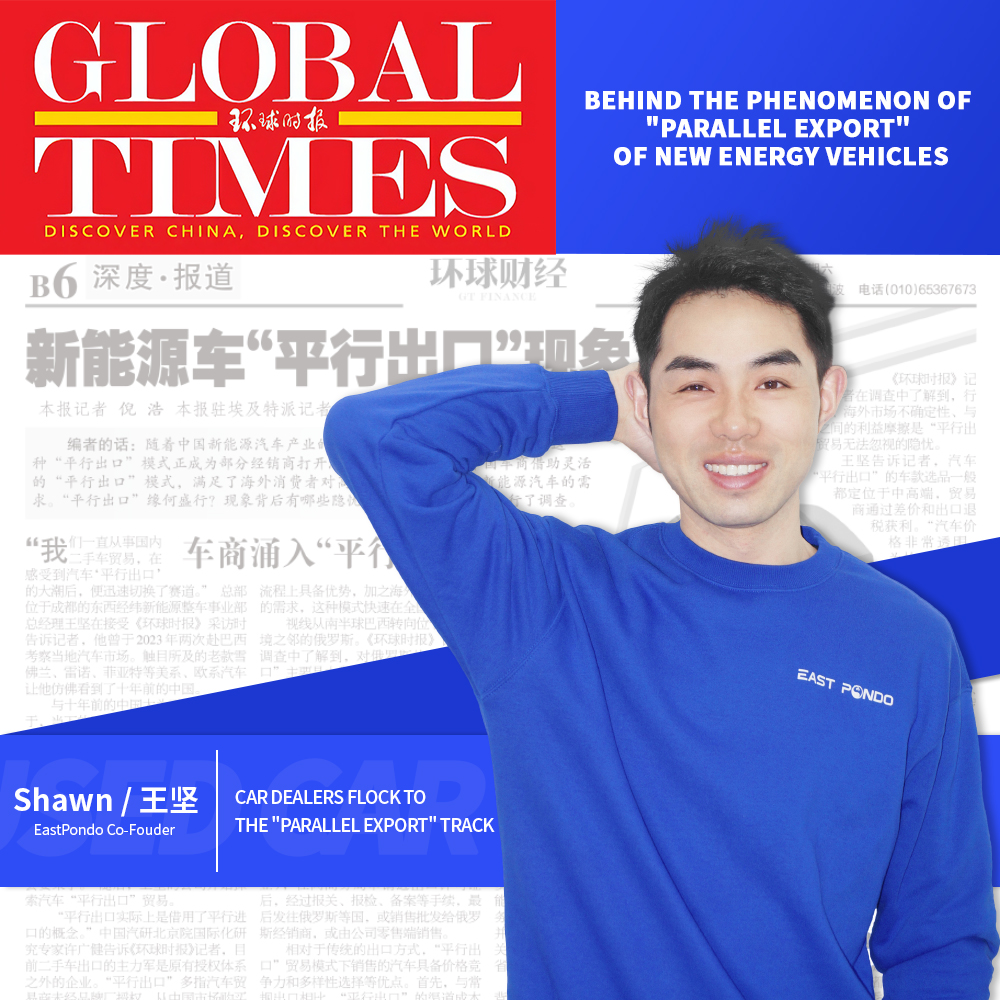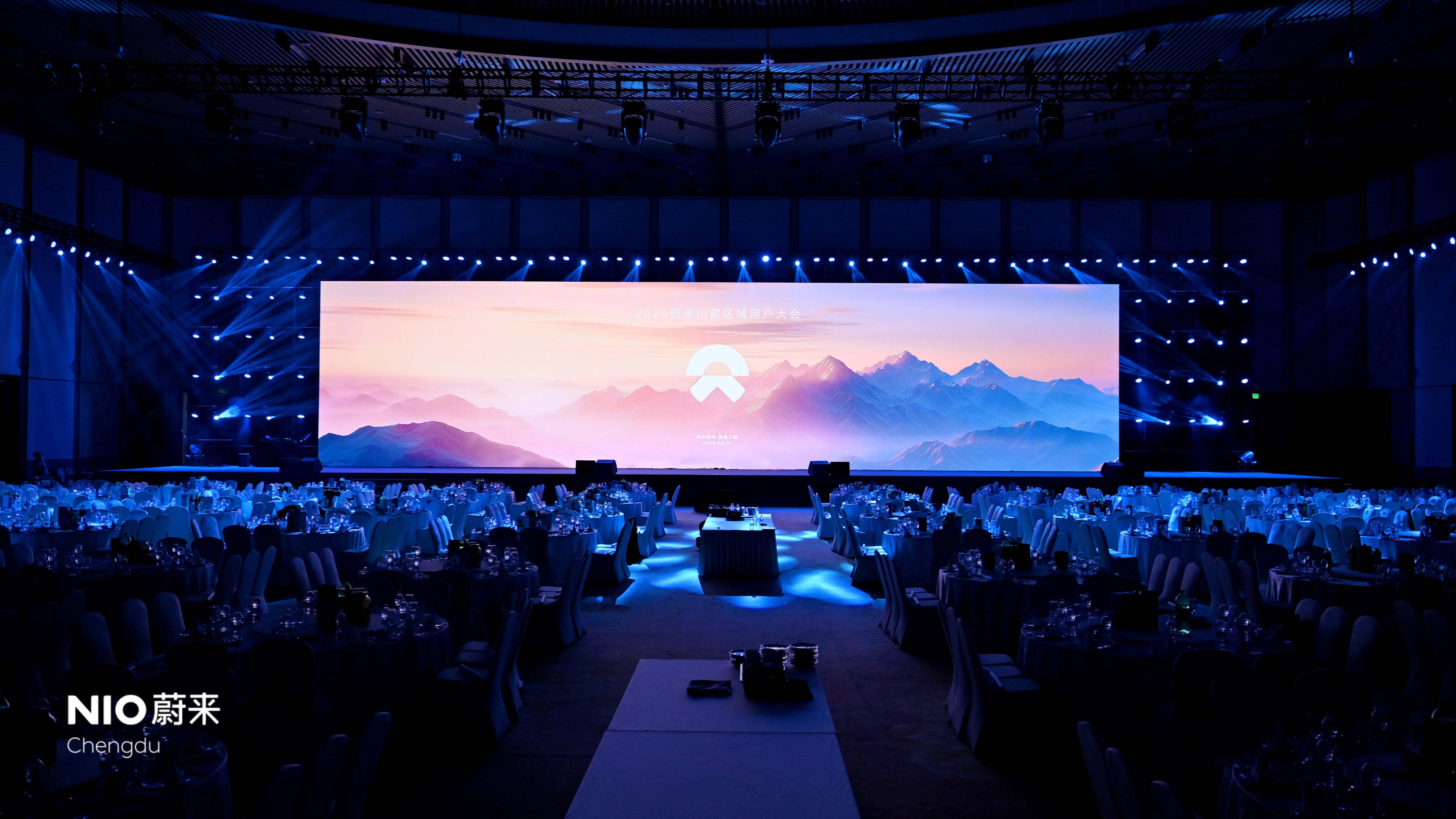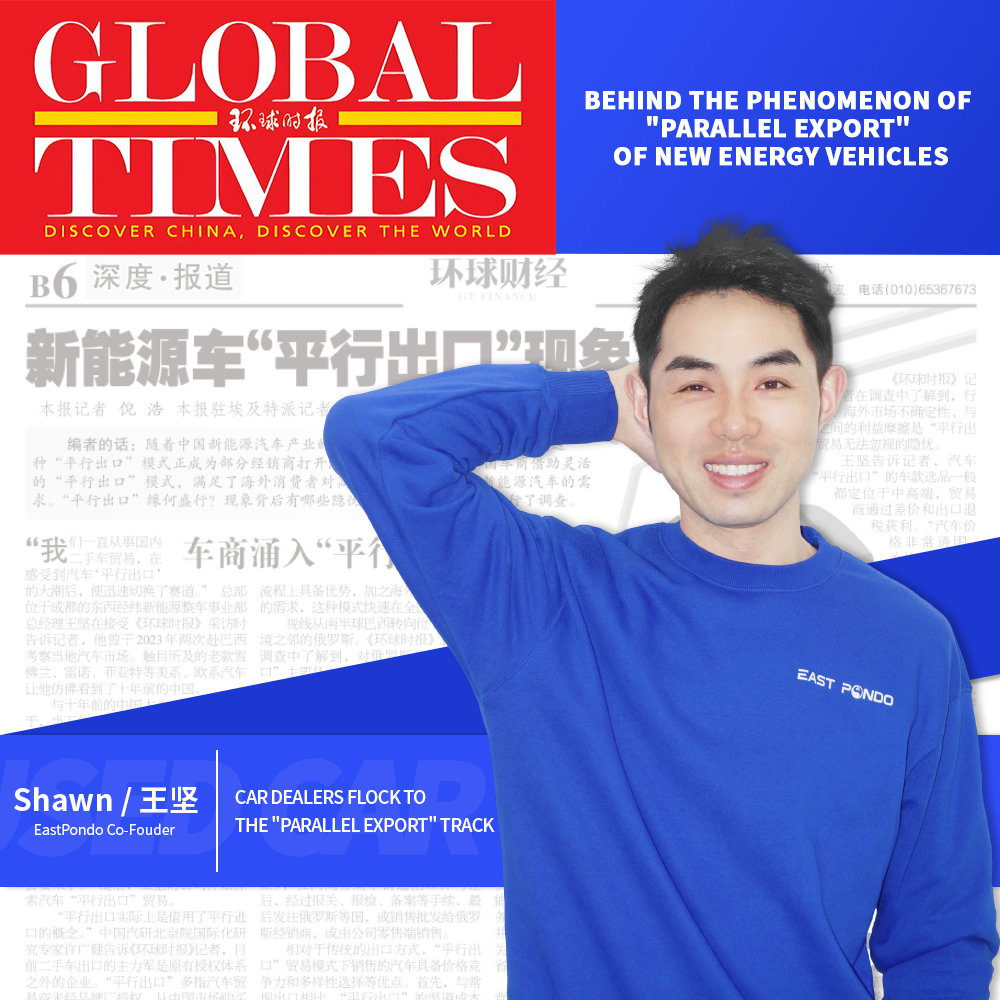Global Times Interviews EastPondo: Chinese Used Cars Enter Overseas Markets in "Parallel Export" Mode
Global Times Reporter Ni Hao
Global Times Special Correspondent In Egypt Huang Peizhao · Bas
Editor's Note: With the rise of China's new energy vehicle industry, the "parallel export" mode, selling new cars under the guise of used cars, is becoming a new approach for some dealers to tap into overseas markets. Chinese car dealers, utilizing the flexible "parallel export" mode, are meeting the overseas demand for high-cost performance, advanced-function new energy vehicles. Why is "parallel export" prevailing? What hidden concerns lie behind this phenomenon? Global Times reporters conducted an investigation.The EastPondo team contributed their knowledge.

Car Dealers Entering the "Parallel Export" Track
"We have been engaged in domestic used car trade, and after feeling the surge of automotive 'parallel export,' we quickly switched tracks," said Wang Jian(Shawn Wang), General Manager of the EastPondo New Energy Vehicle Division, based in Chengdu, in an interview with the Global Times. He visited the Brazilian automotive market twice in 2023 and saw a plethora of old Chevrolet, Renault, Fiat, and other American and European cars, reminiscent of China ten years ago.
Unlike China ten years ago, Brazil is currently in a new era of booming new energy vehicles. Despite the distance, the prosperity of China's new energy vehicle industry has shown Wang Jian, as an automotive trader, the vast business opportunities in overseas markets.
Wang Jian began to contemplate, "When doing domestic business, we thought about selling used cars overseas. However, at that time, compared to foreign brands, Chinese traditional oil vehicles did not have many advantages, and opportunities were limited. But with the increasingly hot production and sales of new energy vehicles in China today, opportunities are arising." Subsequently, Wang Jian's company started exploring the automotive "parallel export" trade.
"In fact, 'parallel export' borrows the concept of parallel import," said Xu Guangjian, an international research expert at the China Automotive Technology and Research Center in Beijing, told the Global Times. Currently, the main force of used car exports comes from enterprises outside the original authorization system. "Parallel export" mostly refers to automotive traders purchasing new cars from the Chinese market without brand factory authorization, and then selling these cars to overseas markets under the guise of used cars. With many intermediate links eliminated, and combined with the explosive demand in overseas markets, this model quickly spread nationwide.
Shifting focus from Brazil in the Southern Hemisphere to Russia, located adjacent to China's northern border. The Global Times learned during the investigation that "parallel export" to Russia is mainly carried out by private dealers or intermediaries who import cars from China through their own channels and then sell them in the Russian market.
Heilongjiang Kaihua Automobile Import and Export Trade Co., Ltd., specializing in "parallel export" business, has been operating in Russia for two years, exporting hundreds of cars monthly. The Global Times interviewed Jing Milong, General Manager of the Moscow-based Tung Tong Automobile Import and Export Co., Ltd., a subsidiary of the group. Jing Milong introduced, "The basic process of 'parallel export' includes purchasing cars and settling them in domestic companies, then transferring them to specialized import and export business branches (pilot enterprises) in the form of used cars (actually nearly new cars). After applying for import and export permits from the Commerce Bureau, going through customs declaration, inspection, record-filing procedures, and finally exporting to Russia and other countries, or selling wholesale to Russian dealers, or retailing through company outlets."
Compared to traditional export methods, cars sold under the "parallel export" trade model have price competitiveness and a variety of choices. First, compared to conventional exports, the channel cost of "parallel export" is lower and does not require additional fees to official dealerships, thus having a price advantage. Secondly, the exported models are more diverse because the initiative of "parallel export" cars lies with foreign trade companies, making operations more flexible. They can export not limited to brands and models provided by official dealerships, better meeting individual needs and preferences. This is why many popular domestic models can immediately appear in overseas markets shortly after their launch.
Sun Xiaohong, Secretary-General of the Automobile Branch of the China Chamber of Commerce for Import and Export of Machinery and Electronic Products, told the Global Times that there is no concept of "parallel export" in national policy documents, but rather the export of used cars. According to relevant regulations, once a car is invoiced, reselling it is considered a used car.
Xu Guangjian told the Global Times that China has been implementing qualification authorization management for car exports since 2012. However, at that time, there were many channels for used car circulation, and it was almost impossible for individuals and ordinary used car dealers to reach authorization agreements with manufacturing companies. In 2018, the Ministry of Commerce initiated research on the pilot work of used car exports and, on April 29, 2019, jointly approved the first batch of 10 provinces and cities, including Beijing, Tianjin, and Shanghai, to carry out used car export business.
Currently, against the background of booming production and sales of new energy vehicles in China, more and more automotive traders are entering the "parallel export" track. According to Wang Jian's estimation, there are no less than a hundred automotive traders engaged in "parallel export" business in Chengdu alone.
Hot Demand Behind: "Proud to Own Chinese New Energy Vehicles"
Several industry insiders interviewed by reporters indicated that the rise of used car exports, especially "parallel export," has significant industrial inevitability, driven by natural maturity at both ends of supply and demand. Zhang Shaoqian, Director of the International Business Department of Yingkun Automobile Export, told the Global Times that in the era of burgeoning new energy, overseas consumers actually have few choices, with few multinational brand models and high prices. In contrast, Chinese new energy vehicles combine various advanced features, such as attractive appearance, spacious interiors, large screens, large seats, and various electronics, especially a range of intelligent functions, deeply attracting overseas consumers. "They (overseas consumers) are fascinated at first sight and proud to own a Chinese new energy vehicle," said Zhang Shaoqian.
"For brand car companies, overseas layout is a huge project. The relatively flexible automotive parallel export is then prominently displayed," Zhang Shaoqian told reporters. Chinese new energy vehicles are highly favored overseas, and to fully experience various advanced features of Chinese cars, many people are willing to learn Chinese painstakingly, just to use the car system.
In many countries, including the Middle East and Africa, the "parallel export" of Chinese electric vehicles has become common. The Global Times observed that although Chinese car companies such as BYD, Great Wall, and Chery have established sales networks in the Middle East region, many well-known brands have yet to establish sales channels locally, providing opportunities for the "parallel export" of Chinese electric vehicles.
Some commentators believe that it is the rise of China's new energy vehicle industry that is driving the forefront of used car exports. According to data from the Russian automotive analysis agency Autostat, among the top 10 best-selling car brands in Russia in 2023, except for the Russian local brand Lada ranked first, the 2nd to 6th places were dominated by Chinese brands in the mid-to-high-end market.
With policies gradually loosening, the environment for exporting used cars is also maturing. Xu Guangjian told reporters that in 2021, China's used car exports exceeded ten thousand for the first time, reaching 15,000 units; by 2023, the scale of used car exports reached 275,000 units. In terms of regions, the coverage of "parallel exports" is extensive yet relatively concentrated. Mainly, it involves several countries like Kyrgyzstan, Russia, Uzbekistan, and the UAE. Among them, Kyrgyzstan, Russia, and Uzbekistan collectively account for over 50%; the UAE (around 14%) acts as a transit point, mainly selling to parts of Africa and the Middle East. Moreover, Eastern Europe has over 5,000 units. Traditional fuel cars and new energy vehicles each account for 50%.
Xu Guangjian believes that in the future, there is still ample space for the export of used cars from China. "Comparing with Japan, which exports over one million used cars annually, and South Korea, with over 400,000 units, we should have more room. Used cars will become an important part of China's automotive industry internationalization. Essentially, this relies on the advantages of China's new energy vehicle industry chain and product cost-effectiveness. We indeed have many leading positions in terms of technology and configuration, which are important sources of our competitiveness."
Zhang Shaoqian believes that when a car company formally enters a certain country, it needs to invest heavily in building sales systems, after-sales maintenance systems, and brand image, which brings great pressure. However, as more and more Chinese new energy vehicles come to Central Asia and Russia, and even the Middle East and Africa markets through "parallel exports," the after-sales service system of the host factory gradually improves due to cost dilution. "From this perspective, the parallel export trade of cars is also promoting the process of China's automotive industry going global."
Hidden concerns behind cannot be ignored
The Global Times reporter learned from the investigation that industry competition, uncertainty in overseas markets, and friction of interests with car companies are hidden concerns that parallel export trade cannot ignore.
Wang Jian told reporters that the car models for "parallel export" are generally positioned in the middle to high-end segment, and traders profit through price differences and export tax rebates. "Car prices are very transparent, to attract customers, everyone squeezes profits very low, and it's all like this. It's becoming increasingly difficult to profit from price differences, now we're just making some money from tax rebates."
The uncertainty of overseas market policies also troubles domestic car traders. In the past, companies engaged in "parallel export" mainly exported cars to Central Asian countries and Russia from ports such as Horgos, Heihe, Suifenhe, and Manzhouli. As there are tax exemption agreements between the members of the Eurasian Economic Union, as long as they enter non-Russian member countries of the union, they can enter Russia with zero tariffs. Kyrgyzstan's car clearance conditions are more favorable than Russia's, so many "parallel export" traders choose to enter Kyrgyzstan first through the Horgos port and then enter Russia. According to data from the Kyrgyz National Statistics Committee, from 2021 to 2023, Kyrgyzstan's imported car data surged from 13,000 to 184,000 units.
Not long ago, the Russian government issued Decree No. 152, which, after April 1, 2024, will regulate the import of cars from Eurasian Economic Union countries, and all attempts to save customs clearance fees will be prohibited. Zhang Shaoqian said, "During the entire first quarter of this year, the sales of Chinese new energy vehicles parallel exported to Central Asia and Russia were quite bleak. To hedge against the policy impact, many traders have already shipped a large number of goods to Russia in advance. It will also take time to digest these accumulated inventories, and the export speed will further slow down."
"Parallel exports" also inevitably affect the interests of car companies. Unofficial overseas expansion may not only disrupt the original overseas expansion plans and pricing systems of car companies but also cause difficulties in consumer maintenance and upgrades, and even harm product brands. The Global Times reporter learned in the Middle East and North Africa that some Chinese car companies have even issued notices stating that new energy vehicles purchased from unauthorized dealers in overseas markets will not enjoy warranty services. Wang Jian said, "It's almost impossible to rely solely on traders to solve the after-sales maintenance of overseas customers, so we still hope that the host manufacturers will increase their efforts to go overseas and jointly promote the export of Chinese new energy vehicles."
Sun Xiaohong said that compared to the over 5 million exported cars from China last year, "parallel exports" of used cars account for less than 5%. In Sun Xiaohong's view, when cars go overseas, they must come with services, and the lack of after-sales guarantees in "parallel exports" is actually not conducive to the long-term development of Chinese car brands overseas. "Compared with the experience of Japan and South Korea, the real potential for development lies in genuine used car export business."
Reprinted from Global Times :https://baijiahao.baidu.com/s?id=1798711043820286341&wfr=spider&for=pc













